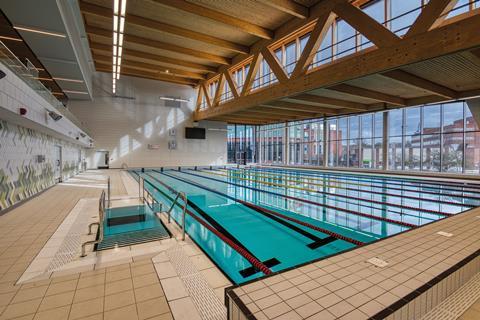- News

All the latest updates on building safety reformRegulations latest
- Focus
- Home
- News
- Focus
- Comment
- Events
- CPD
- Building the Future
- Jobs
- Data
- Subscribe
- Building Boardroom
Take a dive into the UK’s first Passivhaus leisure centre
By Thomas Lane2022-02-16T09:51:00

Source: Oliver Lane
Exeter council trailblazes a radical alternative to the energy-guzzling swimming pool

Source: Oliver Lane
The main pool area features a glulam truss supporting the roof above. Passivhaus levels of insulation mean relative humidity can be increased by 5% without risk of condensation, cutting energy-sapping evaporation from the pool
Many building types have been built to the Passivhaus standard. Examples include homes, schools, university buildings, offices and even archive stores. But no one had built a Passivhaus leisure centre outside Germany, where there are just two examples.
So it was a brave step for Exeter council to trailblaze the way by building the UK’s first Passivhaus leisure centre, particularly as it is much larger than the German examples. Leisure centres guzzle energy, as swimming pools are heated to 30ºC and standards dictate that for each bather using the pool, 30 litres of water need to be dumped and replaced with the same volume of heated water.
Pool halls, which are large, lofty spaces, are also heated to similar temperatures to keep bathers comfortable when they leave the water, and hot water use is high as swimmers and gym users want showers after their session. Unlike the usual Building Regulations, Passivhaus standards regulate all energy use in buildings, which means that all these multiple demands need to be considered and energy use pared down to the bare minimum.
…
Already registered? Login here
To continue enjoying Building.co.uk, sign up for free guest access
Existing subscriber? LOGIN
Stay at the forefront of thought leadership with news and analysis from award-winning journalists. Enjoy company features, CEO interviews, architectural reviews, technical project know-how and the latest innovations.
- Limited access to building.co.uk
- Breaking industry news as it happens
- Breaking, daily and weekly e-newsletters
Get your free guest access SIGN UP TODAY

Subscribe now for unlimited access
Subscribe to Building today and you will benefit from:
- Unlimited access to all stories including expert analysis and comment from industry leaders
- Our league tables, cost models and economics data
- Our online archive of over 10,000 articles
- Building magazine digital editions
- Building magazine print editions
- Printed/digital supplements
Subscribe now for unlimited access.
View our subscription options and join our community


















